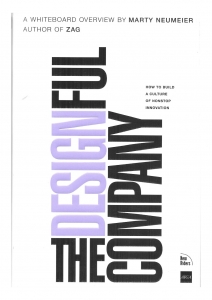The one sentence summary
Old thinking will not solve modern complex business problems, so we now need to design our way forward through constant innovation.
WHAT THE BOOK SAYS 
- Social planner Horst Rittel defined wicked problems – those so persistent, pervasive or slippery that they seem insoluble. The narrow gauge mindset of the past is insufficient for solving today’s wicked problems.
- To reorganise for agility, your company needs to develop a ‘designful mind’.
- Most business managers are deaf, dumb and blind when it comes to the creative process. They are so obsessed with money and process that in their world the language of design is a sound that only dogs can hear.
- Certain people are particularly suited to design thinking. They tend to be:
- Empathetic: to understand motivations and invent engaging experiences.
- Intuitive: a shortcut to understanding situations.
- Imaginative: new ideas come from divergent thinking.
- Idealistic: headstrong, dreamy, and often focusing on something that initially seems wrong.
- Business reasoning is inductive (observing that something works) and deductive (proving that something is). Design reasoning is ‘abductive’ (imagining that something could be). Only the latter can solve mysteries and find new solutions.
- Logical managers think that creativity has four clear phases: discovery, ideation, refinement, and production. This logical sequence no more describes the creative process than a wedding describes sex.
WHAT’S GOOD ABOUT IT
- “What do you really want? “ is a powerful question to ask clients.
- Good design exhibits virtues like generosity, courage, diligence, honesty, substance, clarity, thriftiness and wit.
- Companies should operate a Concept Collection Box, where anyone regardless of rank and title can suggest innovative ideas.
- Traditional companies focus on cost, command and control, job roles, and silos.
- Designful companies empathize with those outside the company, concentrate on vision and creativity, are project-orientated, and collaborate all the time.
- “Thinking wrong” enables designers to think differently.
- Levers for change include taking on wicked problems, weaving a rich story, establishing an innovation centre, assembling metateams, kicking ideas around (“spitballing”), and collaborating.
WHAT YOU HAVE TO WATCH
- Nothing. As usual, this is pithy and sharp.
